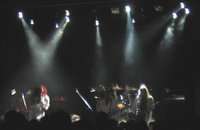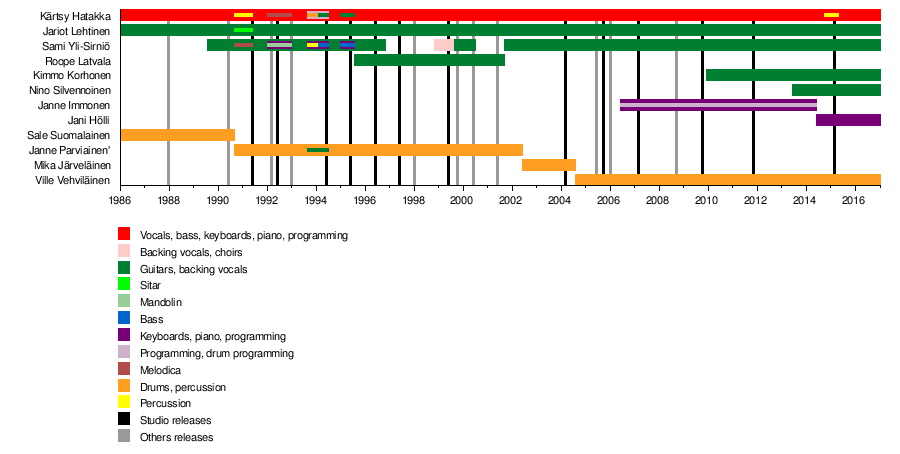Waltari
| Waltari | |
|---|---|
| Origin | Helsinki, Finland |
| Genres | Experimental metal, alternative metal, progressive metal |
| Years active | 1986–present |
| Labels | Stupido Records, The All Blacks, Spin Records, EMI, Edel Records, Parlophone, Vindauga, Bluelight Records, Dockyard 1 |
| Associated acts | Kreator, Ensiferum, Children of Bodom, Amorphis, Sinergy, Barathrum, Stone, Barren Earth |
| Website | Official Website |
| Members |
Kärtsy Hatakka Jariot Lehtinen Sami Yli-Sirniö Ville Vehviläinen Kimmo Korhonen Nino Silvennoinen Jani Hölli |
| Past members |
Sale Suomalainen Janne Parviainen Roope Latvala Mika Järveläinen Janne Immonen |
Waltari is a band from Finland, known for its diversity and combination of music styles, frequently combining alternative metal, progressive metal, death metal, hard rock, heavy metal, hip hop, industrial, pop, punk, symphonic metal, techno and thrash metal.[1]
Most of the band's music is written by Kärtsy Hatakka. Waltari's lyrics often deal with personal feelings of anxiety, loneliness and the cruelty of the world, often with heavy irony and sarcasm.
The name Waltari is a reference to the popular Finnish author Mika Waltari, a favourite author of guitarist Jariot Lehtinen.
History

Waltari was formed in 1986 in Helsinki, Finland, by Kärtsy Hatakka (vocals and bass), Jariot Lehtinen (guitars) and Sale Suomalainen (drums). Sami Yli-Sirniö joined as second guitarist in 1989, a year after the release of their first EP, Mut Hei ("But, hi!").
Their second album, Monk-Punk, was released in 1991. As the title suggests, this album was mostly punk. Their next album Torcha! (1992) was the album on which Waltari started blending various musical styles into the sound that would become their own.
After releasing a compilation of early work under the title Pala Leipää ("A Piece of Bread") (1993), the band went on to release So Fine! (1994), an album similar to Torcha!. Their next album, Big Bang (1995) is to date their biggest success. The album concentrates on mixing techno with heavy metal.
In 1995, Roope Latvala (current second guitarist of Children of Bodom) joined the band, replacing Sami Yli-Sirniö. At this time, Hatakka was working with conductor Riku Niemi on a project combining heavy metal with classical music. This project eventually became known as Yeah! Yeah! Die! Die! Death Metal Symphony in Deep C. The show was performed in 1995, and the album was released in 1996.
In 1997, the band released Space Avenue, a more progressive work containing more electronic drums, as well as a collaboration with Apocalyptica. In 1998, to celebrate their ten-year anniversary, the band released a compilation titled Decade.
In 1999, Kärtsy Hatakka and Waltari were working on yet another metal/classical collaboration, and this gave rise to the stage show Evangelicum (Evankeliumi). This production differed from Yeah! Yeah! Die! Die! in that it contained more than just music: the stage show contained music, ballet and a light show. This spectacle also featured a new opera singer. The guest vocalist was Tarja Turunen, who was the lead vocalist of the still young band Nightwish. The coreographer was Jorma Uotinen. This show was released in 1999 on DVD. A musical album version of Evankeliumi was not released.
Waltari's next album, Radium Round (1999), featured a strong pop influence. After Radium Round, the band passed out of the public eye, working on less mainstream releases such as the metal / yoik crossover Channel Nordica (2000) and the punk EP Back To Persepolis (2001). However, these releases were very hard to obtain, and for a while Waltari only survived through its live shows. In 2001, the band's old guitarist Sami Yli-Sirniö returned, and Roope Latvala left the band.
In 2004, Waltari released an all-new studio album, Rare Species. The album was well received by critics, and an extensive tour put Waltari back on the map.
The Blood Sample album was released in 2005. In 2006, "Early Years" was released, a double album presenting remastered versions of the first album Monk-Punk and Pala Leipää, containing additional tracks from the 1980s, never released before and recorded in autumn 2005 by the original trio: Jariot, Kärtsy and Sale.
Waltari released the album Release Date in 2007. This album includes bonus track "Spokebone", a collaboration with Amorphis singer Tomi Joutsen and Finnish ethnic band Värttinä.
Below Zero was released in 2009.
Covers All, a cover album, was released in 2011.
Their album You are Waltari was released on February 27, 2015. A single, Digging the Alien, was also released as a music video.[2]
Band members
Current members
- Kärtsy Hatakka — bass, lead vocals, keyboards (1986—present)
- Jariot Lehtinen — guitars, backing vocals (1986—present)
- Sami Yli-Sirniö — guitars, backing vocals (1989—1995, 1999, 2001—present)
- Ville Vehviläinen — drums (2004—present)
- Kimmo Korhonen — guitars, backing vocals (2009—present)
- Nino Silvennoinen — guitars, backing vocals (2013—present)
- Jani Hölli — keyboards (2014—present)
Past members
- Sale Suomalainen — drums (1986—1990)
- Janne Parviainen — drums (1990—2002)
- Roope Latvala — guitars (1995—2001)
- Mika Järveläinen — drums (2002—2004)
- Janne Immonen — keyboards, programming (2006—2014)
Timeline

Discography
Albums
- Waltari (1988)
- Monk-Punk (1991)
- Torcha! (1992)
- Pala leipää (compilation, 1993)
- So Fine! (with Angelit, March 1994)
- Big Bang (1995)
- Yeah! Yeah! Die! Die! Death Metal Symphony in Deep C (1996)
- Space Avenue (1997)
- Decade (compilation, 1998)
- Radium Round (1999)
- Channel Nordica (with Angelit, 2000)
- Rare Species (2004)
- Blood Sample (2005)
- Early Years (double album, remastered + additional tracks, 2006)
- Release Date (2007)
- The 2nd Decade - In the Cradle (compilation, 2008)
- Below Zero (2009)
- Covers All (2011)[3]
- You are Waltari (2015)
EPs
- Roskia/Avfall EP (1989)
- Mut Hei EP (1990)
- Aika tuulee EP (1992)
- Misty man EP (1994)
- Blind zone EP (1997)
- Back to Persepolis EP (2001)
Bibliography
- Tuomola, Pauliina (2011). Waltari – suomimetallin pioneerit. Helsinki: Like. ISBN 978-952-01-0624-9.
References
- ↑ Musicmight biography
- ↑ "Waltari - Digging the Alien".
- ↑ "Open your Mind to the World of Waltari". Waltarimusic.com. 2010-07-24. Retrieved 2012-04-10.
External links
| Wikimedia Commons has media related to Waltari. |